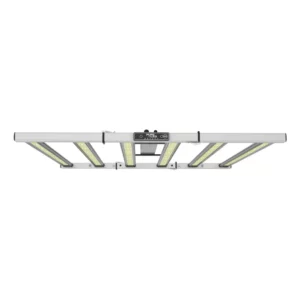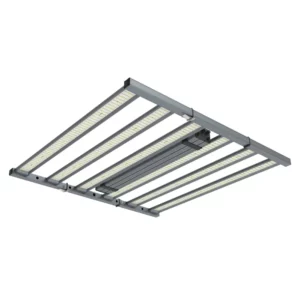Glossary of lighting terms

Talk to any cannabis grow Lighting professional and you’ll probably find yourself, after a while, immersed in a soup of acronyms that are difficult to understand. We all use acronyms, but sometimes we forget that the general public may not know our favorite abbreviations. Hopefully, this glossary of terms will allow you to blend seamlessly into any conversation related to marijuana lighting, as well as allow you to purchase grow products with complete confidence.
The world of lighting for cannabis Cultivation can sometimes be confusing. Among the countless manufacturers, lamp types, product names and descriptions, navigating through a whole ocean of concepts is no easy task. In addition, acronyms can be overused or taken lightly, which can leave people disoriented. And to top it off, most of these acronyms come from English, as they are often used as an international standard. So, to clear up any confusion, we’ve put together the main acronyms you need to know.
A (Ampere): unit used to measure the intensity of an electric current. In simpler terms, it measures the amount of electric charge flowing through a conductor in one second.
BF (Ballast Factor): value describing how a ballast affects the nominal illumination output of a lamp. For example, a 3000 lumen lamp connected to a ballast with a BF of 0.90 or 90% will produce 2700 lumens (3000 lm x 90% = 2700 lm).
CCFL (Cold Cathode Fluorescent Lamp): fluorescent lamp that emits light without heating its electrodes, applying only high voltage (conventional fluorescent lamps use voltage and heating). CCFLs tend to be less efficient than conventional fluorescent lamps, but offer a lifetime comparable to that of LED lighting.
CRI (Color Rendering Index): a metric used to describe how faithfully a light source can represent the true colors of objects and spaces, where natural light sources such as the sun have a perfect index of 100. Without a light source with a high CRI, things can appear washed out, dull or inaccurate.
CCT (Correlated Color Temperature): unlike CRI, which describes how faithfully a light source represents other objects, CCT describes the color output of the lamp itself and is meant as a general measure of the “coolness” or “warmth” of its light.
CFL (Compact Fluorescent Lamp): a type of fluorescent lamp in which the tube is bent or coiled, usually in a spiral, into a compact shape to reduce space requirements. CFLs usually have a built-in ballast and the popular spectrums are 2700 K (warm) and 5000 K/6500 K (cool), with wattages ranging from 13 W to 200 W.
CD (Candela): unit of measurement of luminous intensity, which is the amount of light emitted in a particular direction. Not to be confused with the lumen (lm), a unit of measurement of the total light output of a lamp or luminaire, without describing a specific direction.
CMH (Ceramic Metal Halide): they are an evolution of metal halide lamps and can fulfill the combined role of MH and HPS Bulbs. They use a very hot ceramic tube to ionize various gases that determine the spectral output of the lamp. CMH bulbs have a very high CRI (up to 96), which means that objects look almost completely natural under CMH light.
CU (Utilization Coefficient): a measure of how much light is emitted from a device and will fall on an area of a specific size. The CU is influenced by the luminous efficiency of the lamp, as well as the geometry and colors of the room.
HEP (High Efficiency Plasma): an emerging illumination technology that uses radiofrequency to stimulate a gas and create a small but very bright plasma ball. HEP lighting offers very high efficacy (over 90 lumens per watt) and perfect color rendering (CRI = 100). However, the technology was only recently commercialized and has not reached a market share comparable to LED.
HID (High Intensity Discharge): a type of lamp that produces illumination by stimulating an enclosed gas with an electric arc and therefore operates at high temperatures. Examples of HID lighting include mercury vapor, metal halide, xenon, high pressure sodium and low pressure sodium lamps.
HPS (High Pressure Sodium): an HID lamp that uses sodium in an excited state to produce light. It is one of the preferred lamps for cannabis cultivation due to its high efficiency. While technically a full spectrum lamp, the greatest output is in the green/yellow/red spectrum (520 nm – 640 nm) and very little in the violet/blue/cyan (400 nm – 520 nm).
HQL (Mercury Vapor Lamp): a subtype of HID lamp where an electrical discharge excites the mercury vapor and causes it to emit visible light. They can be phosphor coated to improve performance and are commonly used in industrial and outdoor lighting applications.
IDL (Induction Lamp): a type of discharge lighting where the gas is not directly stimulated by electrodes, as in fluorescent or HID lighting, but instead uses microwaves or radiofrequency. It has a much longer life than HID or fluorescent lighting because there are no electrodes subject to wear each time the lamp is activated.
K (Kelvin): unit of temperature measurement, although in the lighting industry it is more commonly used to indicate the correlated color temperature (CCT) of light sources.
KW (Kilowatt): unit of measurement of electrical power, equivalent to 1000 watts. This term should not be confused with kilowatt-hour, which is the amount of energy consumed by a one-kilowatt appliance operating for one hour.
LED (Light Emitting Diode): semiconductor devices that emit light when current passes through them. Different materials are used to provide different color outputs. These can be monochromatic (single color) or white (full spectrum) emitting diodes. Due to the relatively low heat, long lifetime and increasing efficiency, they are very popular as grow lights.
-
 Pure Led MAX1.016,40 €
Pure Led MAX1.016,40 € -
 Pure Led EXPERT1.290,00 €
Pure Led EXPERT1.290,00 €
SMD LED (Surface Mount LED): the main difference between the LED types is that their design varies to achieve minimum heat emission. Unlike traditional light bulbs, which emit heat outwards, LEDs emit heat inwards, where the diode itself is located. The better you know how to dissipate it, the less the LED chip will suffer. Thus SMD LEDs are based on an array of diodes on a printed circuit board, encapsulated in semi-rigid resin. It can include blue, green and red diodes to create color combinations.
LED COB (LED Chip on Board): this is another LED packaging technology. Multiple LED chips are mounted directly on a single board or substrate to form a single module. The individual LEDs are small, function as a single light source and are usually the same color (e.g., all white or all blue), so it looks more like a lighting panel than several individual lights, as would be the case when using multiple SMD LEDs.
LEC (Light Emitting Ceramic): new technology based on CMH (Ceramic Metal Halide) where the lights use a ceramic burner, instead of the quartz version of sodium. This results in more natural color, producing more lumens per watt and longer life. Not to be confused with LED, as they are totally different technologies.
LLD (Lamp Lumen Depreciation): the decrease over time in lamp lumen output caused by blackening of the bulb coating, phosphor depletion, filament depreciation and other factors.
LPS (Low Pressure Sodium): a subtype of HID lighting where excited sodium vapor is the light source. LPS lights have very high efficacy, but their color rendering performance is very poor. This limits its use to some applications where the CRI is not important.
LM (Lumen): unit that allows us to measure the amount of light (luminosity or luminous flux) emitted by a source, regardless of factors such as the space to be illuminated or the opening angle of the light beam. This makes it possible, for example, to compare LED bulbs with halogen bulbs to find out which will illuminate more.
LX (Lux): is the flux of light projected by a given source onto a surface located at a certain distance from it. Lux is the International System unit of illuminance or lumens per unit area (one lux is equivalent to one lumen per square meter).

MR (Multifaceted Reflector): a component used to shape the light output of a bulb into a directional beam. MR lamps typically use incandescent, halogen, HID or LED bulbs and are available with screw and plug bases.
µmol (Micromol): one millionth of a mole. It is a measure of the number of PAR photons incident on a square meter per second.
MH (Metal Halide): a subtype of HID lamp that produces its illumination by stimulating vaporized metal halide compounds. They also have the ability to provide ultraviolet light, allowing the plants to generate a greater amount of resin.
PF (Power Factor): ratio between real power and apparent power consumed by lighting fixtures. Real power is represented by the actual watts consumed, while apparent power is the product of the multiplication of voltage and current, measured in volt-amperes.
PAR (Photosynthetically Active Radiation): is the radiation encompassed between the wavelengths of 400 to 700 nanometers and is closely related to plant growth. That is, one capable of producing photosynthetic activity in plants and microorganisms.
PPF (Photosynthetic Photon Flux): measures the amount of photosynthetically active radiation (PAR) emitted by a light source every second and tells us how much usable light (by plants) is emitted by the source in question. The unit of the PPF value is µmol/s (micromoles per second). It is important to remember that a PPF value is not the amount of these photons that actually reach the plant, but a measure of the light emitted.
PPFD (Photosynthetic Photon Flux Density): the amount of PAR photons that actually reach your plant to contribute to photosynthesis. More specifically, photosynthetically active radiation expressed as the number of photons (in micromoles) incident on a square meter every second. This is one of the best measures to determine the uniformity of a lamp, as well as the radiation density.
SSL (Solid State Lighting): any type of lighting that uses LEDs to produce light, rather than incandescent filaments, burning gas or plasma. SSL includes OLED (Organic Light Emitting Diode).
T (Fluorescent tube): a specific type of fluorescent lamp that is tubular in shape and equipped with pins at the ends for connection to the voltage output of a magnetic or electronic ballast. Fluorescent tubes are designated by the letter “T” followed by a number indicating their diameter.
UV (Ultraviolet): radiant energy having a wavelength between 100 and 400 nm (nanometers). It is classified into three different types: UVA (long wave) with a wavelength of 315 to 400 nm, UVB (medium wave) with a wavelength of 280 to 315 nm and UVC (short wave) with a wavelength of 100 to 280 nm.
W (Watt): the unit used to measure electrical power, which is equivalent to one joule per second. One watt is equal to the power in a circuit in which a current of one ampere flows through a potential difference of one volt.
In conclusion, unraveling the world of acronyms in cannabis grow lighting can be challenging, but with this glossary of terms, you now have at your disposal a valuable tool for navigating this complex universe. By better understanding key concepts such as CRI, CCT or PPF, among many others, you will be able to make better decisions when making key purchases for your crop, such as lighting, thus improving the efficiency and results of your projects.
At Pure LED, we are proud to be part of your cannabis growing journey, offering advanced and efficient LED lighting solutions that will help you maximize the performance of your crops. Light your way to success with Pure LED!

No comments